Plankton, <em>Artemia</em> sp, artificial diet and their combinations on the development and survival of goldfish (<em>Carassius auratus</em>) during larviculture phase
Abstract
The aim of this study was to verify the influence of different diets on the development of goldfish (Carassius auratus) larvae and determine the best diet management during its larviculture phase. The experimental design was totally randomized with five treatments and four replicatess, using Tukey test for statistical analysis. Twenty 10L-aquariums were used, where twenty larvae with 5.20 mm length were stocked per aquarium. Quinguio larvae were fed daily ration of different diets: ration alone including 56.00% crude protein (R), plankton (PL), Artemia sp nauplii (AN), ration + plankton (R+PL) and ration + Artemia sp nauplii (R+AN), ad libitum twice a day. Treatment R caused the death of all individuals. AN and R+AN diets provided a higher survival rate (p < 0.05) than PL and R+PL diets. On the other hand, the mean final weight of the larvae fed with R+AN was higher (p < 0.05) than that of the larvae fed with AN. As for mean final length no significant difference (p > 0.05) was observed between the different treatments. Under the conditions of the present experiment, the results led to the conclusion that the different food sources influence the larvae performance, and that the ration + Artemia sp nauplii diet management is the most adequate to goldfish larvicultureDownloads
Download data is not yet available.
Published
2008-05-09
How to Cite
Soares, C. M., Hayashi, C., Gonçalves, G. S., Galdioli, E. M., & Boscolo, W. R. (2008). Plankton, <em>Artemia</em> sp, artificial diet and their combinations on the development and survival of goldfish (<em>Carassius auratus</em>) during larviculture phase. Acta Scientiarum. Biological Sciences, 22, 383-388. https://doi.org/10.4025/actascibiolsci.v22i0.2861
Issue
Section
Biology Sciences
DECLARATION OF ORIGINALITY AND COPYRIGHTS
I Declare that current article is original and has not been submitted for publication, in part or in whole, to any other national or international journal.
The copyrights belong exclusively to the authors. Published content is licensed under Creative Commons Attribution 4.0 (CC BY 4.0) guidelines, which allows sharing (copy and distribution of the material in any medium or format) and adaptation (remix, transform, and build upon the material) for any purpose, even commercially, under the terms of attribution.
Read this link for further information on how to use CC BY 4.0 properly.
0.6
2019CiteScore
31st percentile
Powered by 

0.6
2019CiteScore
31st percentile
Powered by 











1.png)




3.png)













